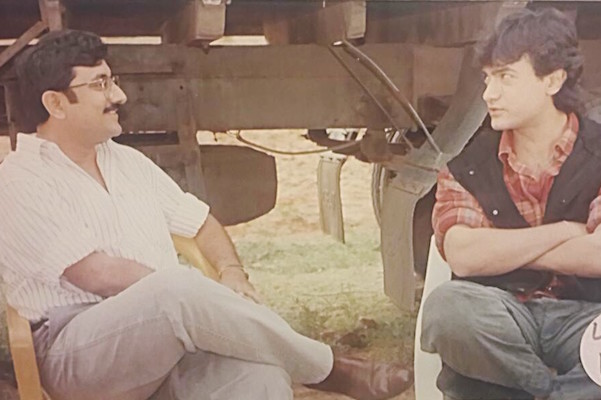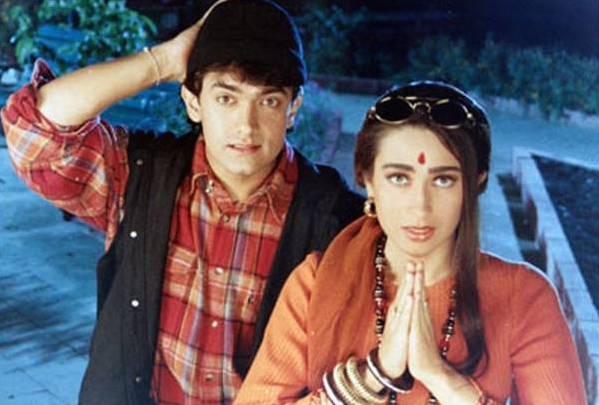As director I had to play psychiatrist, casting agent and what not – Dharmesh Darshan
Artists come and go but their art remains. The archival value that cinema has is highest among other living art forms. Which is what makes us fondly remember some of the iconic stories from the years gone by.
We had a privileged meeting with Dharmesh Darshan who made the blockbuster Raja Hindustani exactly twenty years back. Yes, time flies! It has been twenty years. It was an important film of its time because it was full of many firsts, including one of the most promising and challenging ensemble casts of its time.
Today people are finally open about having a constructive discussion on cinema. That’s one of the major reasons why Dharmesh wants to share his noteworthy experiences now. He doesn’t like to live in past glories and is all set to discuss films again after a sabbatical of five years following the demise of his parents.
On an evening snack of bhel puri at Otters Club in Bandra we chatted about the cinema of the mid 90s upto 2010 – till he was actively working. We were constantly borrowing references from Raja Hindustani and films around that time. Dharmesh seemed like an enthusiastic teenager talking about his craft. We talked about casting, workshops, music and also the ever existing debate between niche and popular.

Dharmesh Darshan
On Casting
Were Aamir Khan and Karisma Kapoor his first choices? How did he manage to get such a challenging ensemble on board? As these questions pop up in our mind, Dharmesh speaks about the casting department and how, unbelievably, it is such a recent phenomenon.
He says, “Casting Aamir Khan was pre-decided. As a director I do not believe in gender biases. I wanted my actress to be as powerful as my actor. I feel that I succeeded in that because a lot of people walk up to me and say that they’d like to rename the film from ‘Raja Hindustani’ (Translated as Indian King) to ‘Rani Hindustani’ (Indian Queen). We were supposed to cast Juhi Chawla for Karisma’s role but as the circumstances would have it, nothing materialized. I feel that it was in Karisma’s destiny. The written graph of her character is also very progressive. She’s a humanist. That’s why it outlasts.”
“Coming to the supporting cast, I tried to give equal weight to all my characters. Even the secondary parts worked as emotional catalysts. I made sure that they looked correct and gave equal weight to their costumes. I introduced the trend of one costume director for the whole film. Earlier it was one stylist per star. Directors back then were a one man army. We used to write, direct, cast and coordinate. It was traumatic to locate actors as there were no mobile phones. At the moment, directors are absolutely lucky to have specialized departments in India as in world cinema. I made sure that all my characters were etched in detail. I have had to play psychiatrist, casting agent and what not (Laughs). I would also go buy props for my set and costume material with my designer. So, you can imagine the input of a director in these popular cult films.”
On workshops
He feels that directors today are blessed with the concept of workshops, which wasn’t possible back in the 90s. He believes in rehearsals and preparing the actors before going on set. Talking about performance styles in Raja Hindustani, the film boasts of frames where we see Aamir Khan approaching the scene in a Stanislavskian realism while Johnny Lever in a pure Brechtian style.
Would the film have been different after an actors’ workshop? Certainly it would have. But Dharmesh argues that workshops back then were a tough nut to crack. Especially, for films with such a huge canvas.
He says, “In that time there was no culture of workshops. And I am talking about the time which is not so primitive. It’s the mid-90s. That’s because the actors were doing so many films simultaneously that there wasn’t any scope. For directors today, it’s a situation of pushing at an open door. But for me, at times it was like trying to make a door out of a wall. Nobody believed in the concept of workshops. It’s a pleasant change and for director’s like me who believe in the strength of rehearsals and workshops, this awareness is certainly going to work as a boon. But one has to carefully handle that as there are also dangers of taking away the spontaneity of on-set performances.”

With Aamir Khan during the making of Raja Hindustani
On Music
Mainstream films have an essential element in the form of songs. We as a nation have songs for all occasions. Why shouldn’t that be reflected in our cinema? It’s common knowledge that our cinema borrows heavily from Parsi theatre tradition and golden Hollywood so it is bound to have musical influences. But Dharmesh feels, the last five years of film music haven’t been as innovative as they should have been.
While enjoying his bhel puri he asserts, “I totally love music. I love music from the 40s, 50s, 60s, 70s, 80s, 90s and 2000. The only disappointment is the film music that has been produced in the last five years. An album has to be a package. There is a dearth of good songs today. Either the albums are very retro, or super club or very sufi. One of the reasons why the Indian film industry has suffered is because of the downfall of music. This has led to unnecessary centralization and tragic monopolization of power. I too am a product of the mid 90s when A.R. Rahman’s era had just begun.”
“My biggest takeaway in terms of music from my earlier films is working with maestros like Nusrat Fateh Ali Khan. When I had started, the golden era of film music had passed. But that glory was then reclaimed. It was not planned. One just worked towards excellence and that truthful intention made them classics. I am not a wannabe in terms of music. I love listening to Mohammed Rafi, Kishore Kumar, Asha Bhosle, Lata Mangeshkar and many more. I don’t like to judge anyone from one’s taste of music. Certainly, one can have a variety of taste. I come from the generation of MTV but for Hindi film music I do not want to do that sort of music. But at the same time I came up with a song like “Chori Chori Hum Gori Se” whose beats were so catchy that the mainstream Hollywood film Guru purchased it and shot it extravagantly.”
On his association with Nadeem Shravan he says that he feels extremely lucky to have worked with people with such great sense of music. “I worked with Nadeem Shravan in Raja Hindustani, Dhadkan and Bewafaa, which had the highest sales in their time. The year that Bewafaa released, it was second to only Veer Zara. Dhadkan was second to only Kaho Naa… Pyar Hai. So, you can imagine the scale. Even my last film Aap Ki Khatir had very good music by Himesh Reshammiya. I am not one of those directors who doesn’t go for a music recording session. I enjoy directing the whole music session as much as the shoot. How can you ignore such an important element of your film’s identity?”

Still from the film
Niche and Popular
Why can’t commercial cinema and art be appreciable to each other’s existence? It’s a debate of right and left. It’s a debate of pure ideology. Why can’t they coexist in harmony?!
“In India, if you are popular, you are either worshiped or condemned. It’s either GOD or DOG. People are over critical. Cinema is multidimensional as a medium. Niche is beautiful but popular has its own place. Unfortunately, people coming to cinema today are misled and confused. People with a command over vocabulary are perpetuating a very wrong message. There are many people who have been dying to work in Bollywood and are still condemning good Bollywood. That’s not artistic fair play. Right now it is being perpetuated as that. Balraj Sahni was a terrific artist but that doesn’t mean that Dilip Kumar wasn’t. Yes, Naseeruddin Shah is a terrific artist but that doesn’t mean that Amitabh Bachchan is not. Right now it has become like that. Dharmendra and Sunny Deol have been fantastic in their own way. To reach out doesn’t mean that you have to be a sell-out. I did reach out to the undefinable masses but made sure that am not enslaved to market forces in spite of having tremendous choices. Hits and misses are everywhere, be it niche or popular. One just needs to be ethical and stick to it. Why have our films survived among world cinema? It’s just because we have had this individuality. We exchange cultures and adapt things from each other but never lose our originality.”
The chat went on and on. We promised to meet again off the record for more talks about contemporary cinema and its influences. But brevity is the soul of healthy conversations so we stopped for the day.
End Credits
Below are excerpts from an iconic conversation from James McTeigue’s film V for Vendetta. Don’t worry about the randomness, the film is connected with Raja Hindustani in a very interesting manner.
“Evey Hammond: Who are you?
V: Who? Who is but the form following the function of what and what I am is a man in a mask.
Evey Hammond: Well I can see that.
V: Of course you can. I’m not questioning your powers of observation, I’m merely remarking upon the paradox of asking a masked man who he is”
Remember this famous conversation between V and Evey from V for Vendetta? The next time you watch this film, don’t forget to watch the complete end credits. You will be surprised to hear an absolute abstract soundtrack that has Hindi tracks mixed with each other. One of the key tracks you hear is “Pardesi Pardesi” from Raja Hindustani. Yes, even Pardesis can’t have enough of this film’s songs (Pun intended). Do yourself a favour and Google this and watch the end credits roll with a subtle soundtrack of “Mere desh ki dharti” playing in the back of your mind and feel proud about the commercial cinema of your country. Like any commercial film let us not end without a song. We leave you here with the song in question “Pardesi Pardesi”. Savour it!!!!



